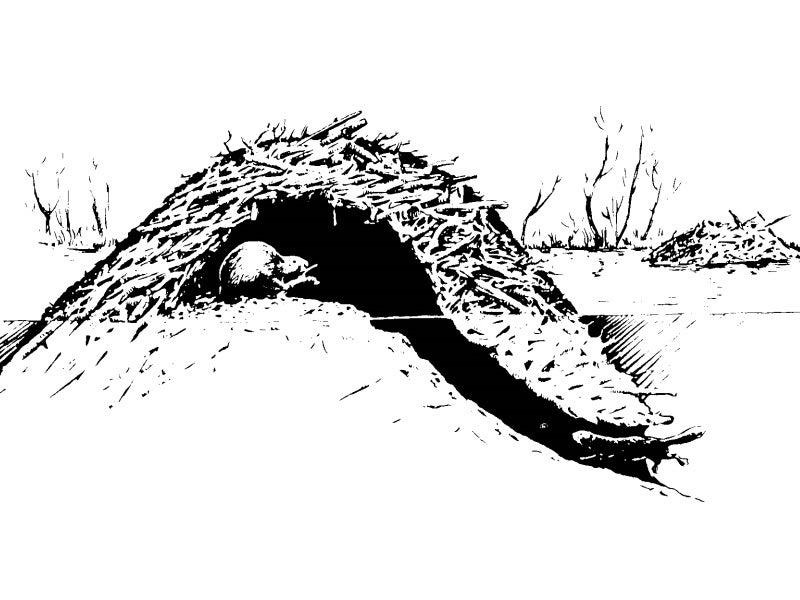Engineers of the San Pedro River
And there's a surfer among them

This page was published 12 years ago. Find the latest on Earthjustice’s work.
The San Pedro, the last free-flowing river of the Southwest, has had an unusual cast of champions. Ecologists, birders, an emergency room physician—and yes, even attorneys—have fought to save the desert oasis’s wealth from being wholesale diverted to indoor plumbing and lawncare.
Then, at the turn of the century, came a group of misfits, putting their hairy paws in service to the San Pedro. They were Castor canadensis—the industrious engineer known as the American beaver.
Beavers were once found across North America in such ubiquity that the famed 18th century surveyor David Thompson was given to remark that “this Continent … from the Atlantic to the Pacific Ocean, may be said to have been in the possession of two distinct races of Beings, Man and the Beaver.”
Thompson went on to note man’s need to “procure clothing from the skins of animals,” and indeed, an insatiable desire for beaver fur led to man trapping and hunting the aquatic animals (once thought to number more than 60 million) quite nearly out of existence.
Arizona’s San Pedro River was itself once dubbed the “Beaver River,” a nod to the numbers lodged among the meandering flows. But no sooner did fur trapper James Pattie bequeath the river’s nickname, did San Pedro’s beavers go the way of the rest of their continental brethren. The final holdouts and their slow-flowing ponds were dynamited out of river in the 1920s, accused (unjustly or not) of aiding and abetting malarial mosquitoes.
Bereft of the beavers and their dams, the San Pedro flowed fast and straight—when it flowed at all. Massive, unrelenting water withdrawals and overgrazing by cattle vastly diminished the river, with long stretches of it bone-dry and dusty for much of the year. Yet it is a testament to the San Pedro’s greatness that even in these lean times, it continues to be a ribbon of undeniable richness to species large and small, winged and scaled—a reminder of what we are poised to lose should this last desert river run dry.
Earthjustice and our partners have fought for nearly a decade against groundwater pumping schemes that would serve the water needs of nearby communities—while leaving none of it for river and the wildlife it sustains. “The upper San Pedro River is the lifeblood of this region,” said attorney McCrystie Adams. “As this river disappears, all the animals and plants that rely on it are dying.”
As Earthjustice works to protect the underground heart of the river, federal wildlife biologists drew inspiration from the past to help mitigate the river’s current woes—and conceived of the beaver’s return to the San Pedro.
Beavers are second only to humankind in their ability to shape the landscape around them. The animal’s efficiency and cleverness in building dams customized just so to their particular stretch of water is legendary. The dams slow the water, and the resulting pond not only protects the entrance of the beaver’s home, but provides ideal habitat for a range of species—and allows the pooled water to gradually seep into the ground and recharge dwindling aquifers.
A total of 15 beavers were drafted between 1999 and 2002. Beavers whose tree-felling, dam-building industriousness ran afoul of local authorities found themselves conscripted into the re-colonization project. One 57-pound fellow, making trouble for a Phoenix water treatment plant, was promptly signed up for the San Pedro after getting himself stuck in a water pipe. He was soon joined by others whose earnest efforts to dam livestock reservoirs and agricultural canals were spectacularly underappreciated by officials, who were all too happy to volunteer the beavers for the San Pedro project.
The beavers took to the San Pedro like they were never gone. Today, there are about a hundred beavers living along the San Pedro, with an average of 30 dams built a year. Some of the beavers headed south of the border (really, who can blame them?) and began building dams on the uppermost reaches of the river, while one traveled as far downriver as the Gila, at northern terminus of the San Pedro, earning him the moniker “The Surfing Beaver.”
Studies have found that the dams contribute to the vitality of the river and in maintaining healthy ecosystems; the deep pools created by beaver ponds have transformed parts of the river back into inviting habitat for diverse species. And as beavers gnaw down trees for food or building material, they double as a natural pruning service, improving forest stands for a whole host of their neighbors, including the endangered southwestern willow flycatcher. A keystone species, the beaver is a small cog with an outsized impact and critical importance on the broader ecosystem—as long as he has water to survive.
Some years have been better to the beavers than others. Nature is a wild and severe place, and beavers have seen their dams washed away by heavy monsoons or been preyed upon by their native predators. But the beavers move on and rebuild, and do their part to reshape the river closer to what it once was. They are thriving, and their return bodes a positive turn for the San Pedro’s future, as Earthjustice works to ensure that the river continues to live so that its water can be shared fairly by all who rely on it—wildlife and humans.
Video: Reintroduction of the Beaver
Watch a charming video from Mike Foster, producer of the San Pedro River Educational Series about the San Pedro River National Conservation Area, on the beaver’s reintroduction to the San Pedro:
Earthjustice’s Rocky Mountain office protects the region’s iconic public lands, wildlife species, and precious water resources; defends Tribes and disparately impacted communities fighting to live in a healthy environment; and works to accelerate the region’s transition to 100% clean energy.